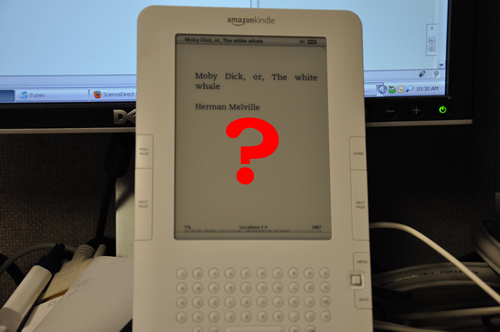We’ve got some toys and ideas coalescing into a full fledged project, but we’ll need your help. Feel free to comment on on this blog, DM us on Twitter (@JCCCLib), or contact me via the e-mail (bbaile14 [at] jccc [dot] edu) if you’d be willing to spend some time sharing your experience with a Kindle, Sony Reader, Nook, or any other type of eBook device or software.
Author: bbaile14
H-2-Oh Snap
/lc.gif&client=johnsonh)
Water : the epic struggle for wealth, power, and civilization by Steven Solomon is all about how settlements and their relationship to water have helped shape society. And this isn’t a “They built it by a river!” lame account of what should be obvious to anyone who has ever been thirsty. This actually goes into detail about dynasties collapsing based on unrest related water, how the Nile’s flood patterns effected their political relations, and how modern civilization is yet to tap into some of these strategic advantages of their water supplies.
And, since I mainly seem to feature books that scare the crap out of me, it is worth noting that it also concludes with a heavy-handed warning that we’ll run out of water and everyone will die. That’s an over-simplification of the message, but the author does emphasize that something must be done as water supplies grow more scarce. That being said, he seems to focus on strategies to make one’s nation superior during times of scarce water as opposed to “How to make more water”, but it doesn’t make it any less interesting.
In Space, No One Can Hear You Ponder
/lc.gif&client=johnsonh)
Forget the stomach exploding, finger glowing, and shoulder-mounted lasers: this book is interested in a much more daunting task than just wondering if there are aliens somewhere. Working on the premise that there must be, Life in the Universe: The Abundance of Extraterrestrial Civilizations by James N. Pierce is much more concerned with trying to calculate just how many there could be. Working on surprisingly not-boring math, the author calculates the possibilities of how many civilizations may be in our galaxy, then takes it to the universe, and differentiates between aliens and alien civilizations.
It’s quite an interesting read, even if you’re just interested in flipping through it for his conclusion. And, like all books featured, it is available for check out at the Billington Library.
The Audacity This Takes…

So today’s book is a fictional compilation of interviews from an author’s past lovers and friends, so a fictional biographer can piece them together. The author in question? John Coetzee. The real author of this work of fiction? John Coetzee. Yeah. I know.
J.M. Coetzee’s Summertime: fiction is an incredible tale about other people trying to find a human side to a man who produced mopey, often shallow or inhumane novels, only to discover the the man who wrote them wasn’t all that sharp or personable. An absolutely incredible work that takes some brass to even write. It is equal parts self-deprecating, entirely ambiguous with reality, and insane spectacle. Though it may sound like an over-indulgent and vain work, Coetzee balances his fictional self in a well-evened manner that takes some real self control to accomplish. Audacious? Yes, in the negative way. Brilliant? Yes, in the most positive of ways.
Hey, We Made the Front Page!
One of the on-going projects at Billington Library is the Fashion Collection’s digitization. It’s a bear of a project, but it is getting it’s exposure on JCCC’s main Web site. The featured article links to this page. Here’s an excerpt:
JCCC is the safe haven for chic and culture as the repository of the Kansas City Regional Fashion Group International collection containing more than 1,500 pieces of apparel: 500 gloves, scarves and undergarments; 275 hats; and 150 pairs of shoes dating from the 1850s to the 1990s.
[…]
The collection has been catalogued and organized by designer and/or decade and is now housed at the college’s site at Bishop Miege North. Electronic images of the collection will eventually be available through the Billington Library.
That’s us! Big thanks to Joan McCrillis for helping the library get this project underway and Bret Gustafson for being the best photographer on the planet, ever.
Somewhere, There’s a Campus
In the Meantime…
We’re running some maintenance on our catalog, which means no new items are being added. That + between semesters = no RSS updates for new materials = slow blog material coming about.
So in the meantime, here’s a video of a prank some jerk pulled at a library I used to work at, which is probably only funny to me because I didn’t have to pick it up.
DARPA: Not Quite Skynet

Defense Advanced Research Projects Agency: it doesn’t exactly bring to mind much more than futuristic military weapons, killer cyborgs, and super soldiers. However, this Pentagon-ran project has led to everything from driverless vehicles to the Internet to, yes, advanced future weapons.
Department of Mad Scientists is an inside look at DARPA and all of the advancements they’ve brought to military and civilian populations with both good and/or controversial results. Author Michael Belfiore attempts to show readers the entire spectrum of DARPA’s projects: at least the ones that can be known. Though it may be a secretive organization, I don’t think we have to worry about DARPA building Skynet.
I think.
The Future Freaks Me Out

In a world now without bees, five people in distant parts of the world become the first sting victims in years, and engage in a prophetic search for the planet’s future. Pulled from the world of drugs, the world of technology, and in one case, The World of Warcraft, a secret militant group apprehends the sting victims as a prophecy unfolds. This is the story in Douglas Coupland’s Generation A.
I’m not gonna lie, this book is pretty crazy. On the other hand, it’s a funny and thoughtful look at technology, society, and pop culture. Though technically a sequel in theme to the author’s book, Generation X, it can certainly be enjoyed on its own.
Crashing the Party?
%20:/lc.gif&client=johnsonh)
One can track a shift in the Republican Party as some members started to focus on issues like homosexuality, Christianity, abortion, abstinence education, or any combination of the aforementioned. Many turned to evangelical church figureheads to be leaders for the party. The schism this may have created and the reasons why it may have occurred are posited in Max Blumenthal’s Republican Gomorrah: Inside the Movement that Shattered a Party. Though it is an examination of many facts, it is also strongly opinionated: Blumental suggests that sexual abuse may have shaped certain key leaders in the movement, and he also works for Media Matters, an organization that montiors the media for bias, but has been accused of leaning left on the political spectrum.
With all the talk on the news about the Republican Party being in what sports teams might call “a rebuilding year,” Republican Gomorrah is an interesting hypothesis about what may have led to it.




